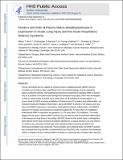Kinetics and Role of Plasma Matrix Metalloproteinase-9 Expression in Acute Lung Injury and the Acute Respiratory Distress Syndrome
Author(s)
Gautam, Shiva; Talmor, Daniel S.; Gallagher, Diana C.; Barrett, Christopher D; Debusk, Michael George; Yaffe, Michael B; Hsu, Albert; Ellson, Chris; ... Show more Show less
DownloadYaffe_Kinetics and role.pdf (728.5Kb)
OPEN_ACCESS_POLICY
Open Access Policy
Creative Commons Attribution-Noncommercial-Share Alike
Terms of use
Metadata
Show full item recordAbstract
Primed neutrophils that are capable of releasing matrix metalloproteinases (MMPs) into the circulation are thought to play a significant role in the pathophysiology of acute respiratory distress syndrome (ARDS). We hypothesized that direct measurement of plasma MMP-9 activity may be a predictor of incipient tissue damage and subsequent lung injury, which was investigated in both an animal model of ARDS and a small cohort of 38 critically ill human patients. In a mouse model of ARDS involving instillation of intratracheal lipopolysaccharide (LPS) to induce lung inflammation, we measured neutrophil-mediated inflammation, along with MMP-9 activity in the airways and lung tissue and MMP-9 expression in the plasma. Neutrophil recruitment, inflammation, and MMP-9 activity in the airways and lung tissue increased throughout the 72 h after LPS instillation, whereas plasma MMP-9 expression was greatest at 12 to 24 h after LPS instillation. The results suggest that the peak in plasma MMP-9 activity may precede the peak of neutrophil inflammation in the airways and lung tissue in the setting of ARDS. Based on this animal study, a retrospective observational cohort study involving 38 patients admitted to a surgical intensive care unit at a tertiary care university hospital with acute respiratory failure requiring intubation and mechanical ventilation was conducted. Plasma samples were collected daily, and MMP-9 activity was compared with lung function as determined by the PaO[subscript 2]/FiO[subscript 2] ratio. In patients who developed ARDS, a notable increase in plasma MMP-9 activity on a particular day correlated with a decrease in the PaO[subscript 2]/FiO[subscript 2] ratio on the following day (r = -0.503, P < 0.006). Taken together, these results suggest that plasma MMP-9 activity changes, as a surrogate for primed neutrophils may have predictive value for the development of ARDS in a selected subset of critically ill patients.
Date issued
2015-08Department
Massachusetts Institute of Technology. Department of Biological Engineering; Massachusetts Institute of Technology. Department of Biology; Koch Institute for Integrative Cancer Research at MITJournal
Shock
Publisher
Ovid Technologies (Wolters Kluwer) - Lippincott Williams & Wilkins
Citation
Hsu, Albert T. et al. “Kinetics and Role of Plasma Matrix Metalloproteinase-9 Expression in Acute Lung Injury and the Acute Respiratory Distress Syndrome:” Shock 44.2 (2015): 128–136.
Version: Author's final manuscript
ISSN
1073-2322